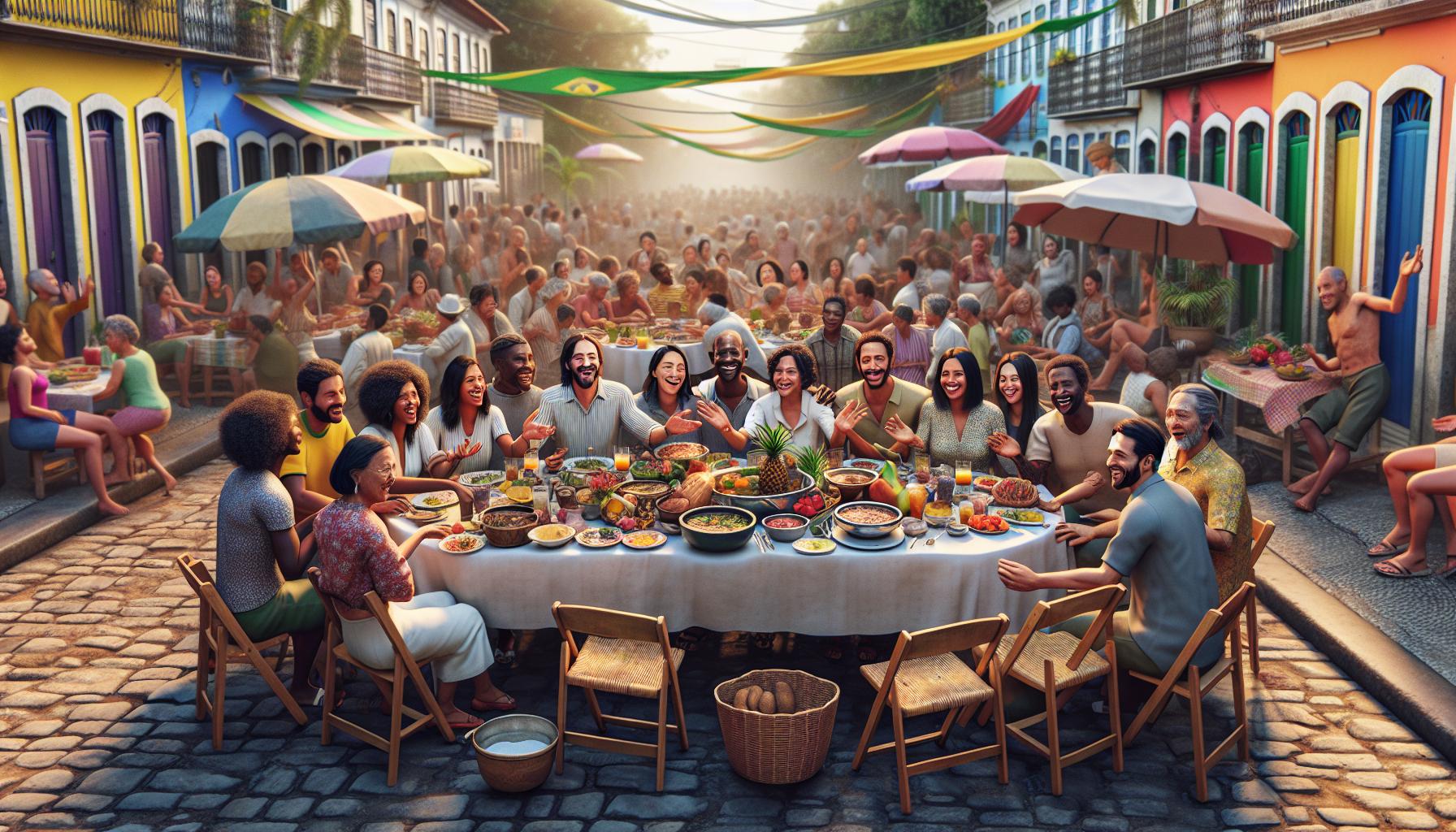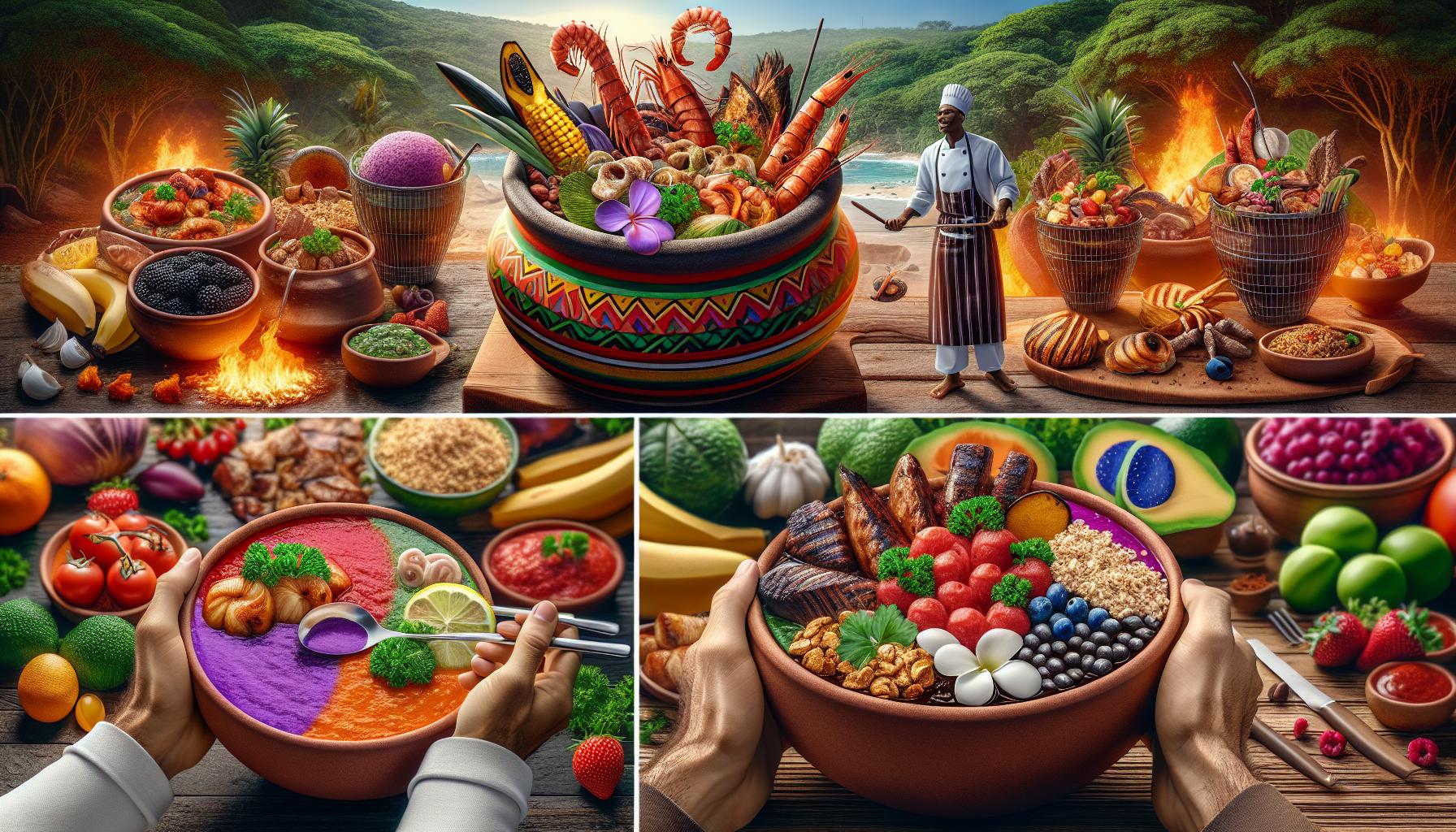Phone:
(701)814-6992
Physical address:
6296 Donnelly Plaza
Ratkeville, Bahamas.

Brazilian cuisine stands as a vibrant tapestry woven from indigenous traditions African influences and European heritage. From the sizzling churrascarias of Rio Grande do Sul to the tropical flavors of Bahia’s moqueca this South American giant serves up a feast for the senses that’s impossible to resist.
The country’s food culture isn’t just about filling stomachs – it’s a celebration of life itself. Brazilians turn every meal into a social event where families and friends gather to share stories laughter and generous portions of feijoada. There’s an unwritten rule in Brazilian homes: no one leaves the table hungry and everyone’s treated like family – even if they’ve just met. This warm hospitality combined with mouth-watering aromas and bold flavors creates an unforgettable culinary experience that keeps food lovers coming back for seconds.
Brazilian cuisine emerged from a unique fusion of culinary traditions spanning three continents, creating a vibrant tapestry of flavors distinct to this South American nation. The foundation of modern Brazilian cooking stems from centuries of cultural exchange between indigenous peoples, Portuguese colonizers, and African influences.
Native Brazilian tribes contributed essential ingredients that define modern Brazilian cooking. The indigenous peoples introduced manioc root, a staple food processed into farofa and tapioca. They developed techniques for preparing açaí berries, hearts of palm, and various tropical fruits native to the Amazon rainforest. Their cooking methods included moqueca (fish stew) preparation in clay pots and the creation of pirão, a fish-based porridge. Traditional indigenous practices also established the use of dendê oil in cooking and the cultivation of native Brazilian peppers.
Portuguese colonizers brought olive oil, cod fish, and wine-based cooking techniques to Brazil in the 16th century. They introduced dairy products, eggs, and wheat flour, transforming local cooking methods through European baking traditions. African influences arrived through enslaved peoples who incorporated palm oil, okra, and black-eyed peas into Brazilian dishes. The feijoada, Brazil’s national dish, originated from this African heritage, combining black beans with various cuts of pork. African cooking techniques also established the use of coconut milk in seafood dishes and the creation of acarajé, deep-fried black-eyed pea fritters.

Brazil’s vast territory encompasses distinct culinary regions shaped by local ingredients, climate, and cultural influences. Each region boasts unique flavors, cooking techniques, and traditional dishes that reflect its geographical location and historical heritage.
The Amazon region features indigenous-inspired cuisine centered around freshwater fish, tropical fruits, and manioc derivatives. Local specialties include tacacá, a hot soup made with jambu leaves, dried shrimp, and yellow pepper, served in traditional gourds. The region’s açaí berries transform into refreshing bowls topped with granola or tapioca. Traditional proteins include pirarucu, the largest freshwater fish in South America, often prepared in stews or grilled with regional herbs.
Brazil’s 4,600-mile coastline produces distinctive seafood dishes that vary from region to region. Bahian moqueca combines fresh fish or shellfish with coconut milk, palm oil, and colorful bell peppers in clay pots. Coastal communities prepare bobó de camarão, a creamy shrimp stew thickened with manioc purée. Fresh catches like robalo, dourado, and octopus feature prominently in coastal recipes, often accompanied by farofa and pirão.
Southern Brazilian cuisine centers around churrasco, a grilling tradition that originated with the gaucho cowboys. Traditional cuts include picanha, costela, and fraldinha, grilled on long skewers over open flames. The region’s Italian immigration influence appears in polenta, risottos, and wine production. German settlers contributed to the region’s strong brewing traditions, complementing the barbecue culture with craft beers.
Brazilian cuisine relies on a foundation of indigenous ingredients enhanced by Portuguese and African influences. These essential components form the basis of traditional dishes across the country’s diverse regions.
Manioc root (mandioca) stands as Brazil’s most significant indigenous ingredient, processed into farofa, tapioca flour and manioc meal. The versatile root creates everyday staples like pão de queijo (cheese bread) and farofa (toasted manioc flour). Black beans and carioca beans appear in signature dishes including feijoada and feijão tropeiro. Fresh beans simmer with pork, beef or dried meat in clay pots seasoned with bay leaves, garlic and onions.
Brazil’s tropical climate nurtures unique fruits like açaí, cupuaçu, jabuticaba and graviola, each bringing distinct flavors to regional dishes. Dendê (red palm oil) adds rich color and nutty taste to Bahian cuisine. Brazilian kitchens incorporate malagueta peppers, urucum (annatto) and fresh herbs like cilantro into traditional recipes. Coconut milk extracted from native palms enriches seafood stews, while fresh lime juice brightens meat dishes and cocktails. Indigenous spices such as Brazilian pink pepper contribute subtle heat and complex aromas to marinades and sauces.
Brazilian cuisine features iconic dishes that represent the country’s cultural diversity through a harmonious blend of indigenous, African, and Portuguese influences. Each dish tells a unique story of Brazil’s culinary heritage.
Feijoada stands as Brazil’s national dish, combining black beans with various cuts of pork, served with white rice, farofa, and collard greens. The traditional preparation involves slow-cooking the beans with smoked meats, bacon, sausages for 12 hours to develop rich flavors. Moqueca, a seafood stew cooked in clay pots, combines fish or shrimp with coconut milk, palm oil, tomatoes, and aromatic spices. Vatapá emerges as another celebrated dish from Bahia, featuring shrimp paste, coconut milk, peanuts, and dendê oil. Additional national favorites include picanha (prime cut beef), galinhada (chicken rice), and acarajé (black-eyed pea fritters).
Brazilian street food captures the essence of casual dining with portable, flavorful options found in urban centers. Pão de queijo dominates breakfast scenes with its chewy, cheese-filled spheres made from tapioca flour. Pastel vendors sell crispy pastries filled with meat, cheese, or hearts of palm throughout city markets. Coxinha presents shredded chicken wrapped in dough shaped like teardrops, deep-fried to golden perfection. Street corners feature tapioca crepes, made from manioc starch, filled with sweet or savory ingredients. Churros, stuffed with doce de leite, satisfy sweet cravings alongside Brazilian hot dogs topped with corn, potato sticks, and multiple sauces.
Brazilian meal customs emphasize communal dining experiences centered around family gatherings. The dining culture reflects strong social bonds through shared plates serving traditions across breakfast, lunch, dinner, and late-night meals.
Brazilian families gather for multiple daily meals, with lunch serving as the main meal from 12-2 pm. Large platters of rice, beans, meat, and vegetables occupy the center of the table for everyone to share. Adults serve children first, followed by elders receiving their portions before others begin eating. Meals typically last 1-2 hours as families engage in conversation while enjoying multiple courses. The practice of “repetir” encourages diners to take second helpings, demonstrating appreciation for the food and cook’s efforts.
Brazilian festivals feature distinct culinary traditions tied to specific celebrations throughout the year. Carnaval brings street vendors selling acarajé, brigadeiros and coxinhas to fuel late-night revelers. Easter celebrations showcase bacalhau dishes alongside chocolate eggs containing special prizes. June festivals honor saints with quentão (spiced wine), pamonha (corn paste), pé de moleque (peanut candy) and grilled corn. New Year’s Eve features lentil dishes symbolizing prosperity while Festa Junina celebrations highlight farm-fresh ingredients like corn, peanuts and sweet potatoes prepared in traditional recipes passed down through generations.
Brazil’s contemporary culinary landscape blends traditional flavors with innovative techniques. The modern food scene embraces both heritage recipes and cutting-edge gastronomy, creating a dynamic environment that attracts global attention.
Brazilian fine dining has transformed significantly since the 1990s, with São Paulo leading the culinary revolution. Renowned chef Alex Atala’s D.O.M. restaurant ranks among the world’s top 50 restaurants, showcasing indigenous ingredients in sophisticated preparations. Modern Brazilian chefs incorporate molecular gastronomy techniques while celebrating local ingredients like priprioca root from the Amazon. Upscale establishments across Rio de Janeiro, Salvador and Brasília feature tasting menus that elevate traditional dishes such as moqueca and feijoada to fine-dining status. These restaurants combine precise French techniques with Brazilian flavors, creating distinctive fusion cuisines that attract international recognition.
Contemporary Brazilian cuisine incorporates elements from Japanese, Middle Eastern and Mediterranean cooking traditions. São Paulo’s Japanese population contributes to Brazil’s position as home to the largest Japanese community outside Japan, influencing dishes like temaki with tropical fruits. Lebanese immigrants introduced dishes such as sfihas and kibes, which evolved into popular Brazilian street foods. Italian influences appear in São Paulo’s pizza culture, featuring unique Brazilian toppings like hearts of palm and catupiry cheese. Korean, Chinese and Thai restaurants expand Brazil’s culinary horizons, adding Asian flavors to the nation’s food repertoire. These international influences merge seamlessly with traditional Brazilian ingredients, creating innovative fusion dishes that reflect Brazil’s multicultural identity.
Brazilian food culture stands as a testament to the power of cultural fusion and the enduring spirit of community. Its vibrant flavors regional diversity and cherished traditions continue to captivate food enthusiasts worldwide.
From humble street foods to sophisticated fine dining experiences Brazilian cuisine proves that food is more than sustenance – it’s a celebration of life history and togetherness. The country’s culinary heritage remains dynamic evolving with modern influences while staying true to its roots.
Through its distinctive ingredients cooking methods and dining customs Brazilian food culture offers a unique window into the heart and soul of this diverse nation. It’s a living breathing testament to Brazil’s ability to transform different cultural elements into something uniquely and beautifully Brazilian.